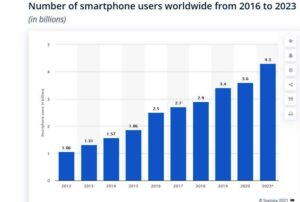The increasing penetration of smartphones in the global population has led to a rise in the demand for newer apps. According to a survey by Statista, the world is at 1.46 billion mobile phone users globally.
iOS and Android are the most prevalent mobile operating system. But despite their architectural similarity, the two systems are very different from one another. In terms of design and development, there are certain differences between the iOS and Android platforms. We have made a list of differences between IOS and Android operating systems for mobile app development.
The programming language
Coding on iOS is currently done by Swift, which appeared in 2014 and is considered one of the most fast-paced coding languages. Swift takes a lot less time and is highly readable.

This is the biggest dissimilarity between the iOS and Android platforms. Android apps are developed using Java, which requires a lot of codes to be written. Kotlin is another alternative for the Android app development programming language. Kotlin is being considered as the future replacement of Java. It is more intuitive and much easier to read.
Integrated development environment or IDE
XCode 8 is used when developing iOS apps. It is a very efficient IDE for Mac or iPhones as it helps to trace errors in syntax and logic as well as get the code fixed.
Another intelligent IDE for the iOS platform is AppCode. This development environment allows coding much faster by automating daily tasks and carrying out code inspections.
Earlier, it was the Eclipse tool that was used for Google-backed application development. At present, Android Studio, a cross-platform, highly functional IDE developed by Google, is used. Android Studio helps to generate multiple versions of the same app for various devices in a short span of time. It has a flexible Gradle-based build system.
User Interface (UI) patterns
For iOS-backed apps, the navigation bar is shifted at the top in their iconic blue or grey color. iOS also focuses on its tab bar, usually placed at the bottom. However, iOS also favors the hamburger menu bar, but that has to be specially customized. Also, iOS devices have the ‘back button at the top left side of the page. This button lets the user go back to the previous page without having to navigate the entire app.
Looking from a design perspective, both operating systems have different UI patterns. The navigation button on Android platforms is placed at the left with colorful icons. Also, Google-backed devices have a drawer or side menu at the left. Android apps also have a greater number of screen sizes and a wide range of screen resolution than iOS devices.
App Testing
In order to develop a successful app for the Android and iOS platforms, it needs to adapt to the specific characteristics of the respective operating system.
It has been observed that the iOS simulator is slightly faster than Android. But at times, the iOS emulator fails to represent a realistic simulation. The iOS simulator works best for apps that need to be developed in a shorter time.
On the other hand, an Android emulator is a virtual machine including the CPU, which makes it much more efficient.
Development complexities
Apple has a limited number of devices- iPhone, iPad, iPod. Whereas Android has a wide range of systems, and that’s why Android-based development is much slower and more complex. There is a dozen of styles, screen resolutions, and sizes. Thus, developers need to run a lot more tests for each one. As a result, the development of Android apps requires more time and iterations to develop.
Google play store vs. Apple App Store
The verification process of the Apple store is much stricter than Google. Earlier, Apple had a 3-week long verification process, but now it has changed to 1-2 days.
Google, is much more reluctant regarding the verification process of the apps.
Complaints of fake apps often appear more in Google Play Store than Apple App Store. In 2018, it was reported that 3.8 million apps are available in Play Store and around 2 million in the App Store.
An app should be based on the type of product or services that you are offering. With these few points, we have outlined the fundamental differences between Android apps and iOS apps developing processes. If you are looking for a solid technical team for iOS app development and mobile app advertising contact KOL Limited. Their experts will develop a custom-made iOS app along with SDKs and frameworks.


